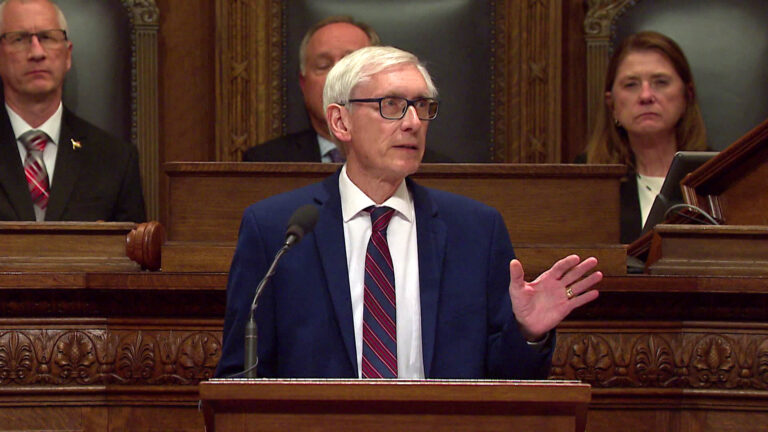IV Bag Shortage Stretches On At Wisconsin Hospitals After Hurricane Maria
One impact of Hurricane Maria in Puerto Rico may continue to plague hospitals in the mainland United States for quite some time.
December 11, 2017

IV bag systems on table at UW Hospital and Clinics screenshot

One impact of Hurricane Maria in Puerto Rico may continue to plague hospitals in the mainland United States for quite some time. The island United States commonwealth hosts a significant concentration of manufacturing facilities that make medical supplies and pharmaceuticals, lured to the Caribbean island over the years by tax breaks.
The American healthcare system as a whole particularly depends on IV bags made in Puerto Rico by a company called Baxter International. Without this important product, procedures from restoring fluids to administering painkillers suddenly become more complicated, creating a logistical strain that can spiderweb across an entire hospital’s operations. Puerto Rico remains devastated amid a slow recovery, with a likely death toll far higher than official estimates. Its pharmaceutical industry isn’t operating at its previous capacity, and getting supplies to the mainland is difficult as well.
But this crisis isn’t just a one-time problem. Medical manufacturers, healthcare providers and government regulators do not coordinate the flow of vital supplies or have a comprehensive way to get ahead of drug or equipment shortages. Officials at the U.S. Food and Drug Administration don’t have a thorough grasp on what medical supplies are made where, which could make it difficult to anticipate when a natural disaster or other emergency could disrupt manufacturers concentrated in a given geographic area.
Whether a given company makes a given product, and how much it makes, can be subject to volatile market forces. If only one company is making an important drug and it goes out of business or decides to focus on more profitable product, it could leave hospitals around the country scrambling to figure out alternatives. As troublesome as the Puerto Rico situation is for pharmacy buyers, they’re becoming accustomed to dealing with increasingly frequent drug and medical supply shortages.
The IV bag shortage has created trouble for Wisconsin hospitals large and small. The main University of Wisconsin Hospital and Clinics campus in Madison goes through thousands of Baxter’s mini-bag systems per day. Nearly three months after Hurricane Maria’s landfall in Puerto Rico, the IV bag shortage is still putting a strain on the hospital, as UW Health manager of patient care services Phillip Trapskin explained in a Dec. 8, 2017 interview with Wisconsin Public Television’s Here & Now.
Earlier the same day, Trapskin joined a group of other healthcare professionals in Washington D.C. to discuss drug shortages with the staffs of Wisconsin Senator Tammy Baldwin and Speaker of the House Paul Ryan. Their trip followed up on a letter the American Hospital Association and other medical groups sent to Congress in November that Hurricane Maria and other natural disasters’ impact on medical manufacturing “now leave the U.S. healthcare system on the brink of a significant public health crisis.”
“I think the hurricane shed some light on vulnerabilities that exist within our supply chain within health care,” Trapskin told Here & Now.
UW Health has been working to line up other sources of IV bags and implement workarounds for common procedures that usually depended on this product. “Luckily, no adverse outcomes have happened with patients at UW. We’ve been able to provide all the medications we need. But it does put strain on the system in terms of opportunities for medication errors when you quickly implement new workflows,” he added.
In the short term, Trapskin fears things might actually get worse. Around the end of the year, medical manufacturers usually slow down or stop production in order to carry out routine maintenance on their factories. At the same time, cold and flu season are ramping up, creating more demand for the very products of those facilities.
“We’re actually nervous given the way the fluids exist today,” he said.
Over the long run, Trapskin advocates for building more consistency and communication into what is now a fragmented supply chain, in which the supply of life-saving drugs or equipment can hinge on the whims of the market or the decision-making of an individual company. Trapskin proposes that policymakers create incentives for companies to produce critical medical supplies like antibiotics, IV fluids and equipment for resuscitating cardiac-arrest victims, and at high enough levels that healthcare providers around the nation can be assured of a consistent supply.
As it is now, pharmaceutical companies don’t often have those incentives from the market, especially if a drug’s price is fluctuating, or if that drug is an inexpensive generic. In both a physical sense and a logistical sense, Trapskin summed it up as an infrastructure problem.
“Players come in and out of the market and don’t always maintain their factories as well as they could,” he said.
 Passport
Passport











Follow Us